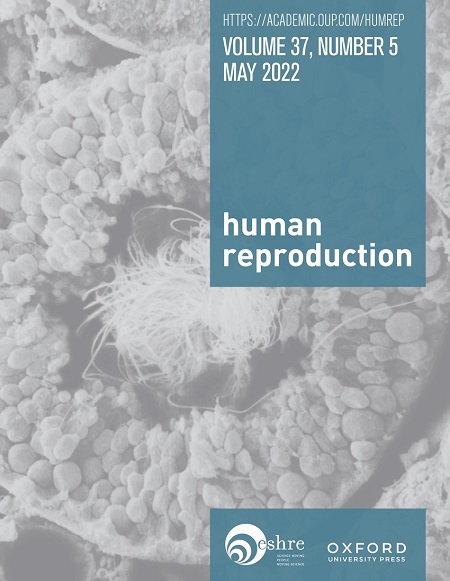Preclinical validation of fast oocyte vitrification and warming protocols with comparable efficiencies to a standard method
IF 6
1区 医学
Q1 OBSTETRICS & GYNECOLOGY
引用次数: 0
Abstract
STUDY QUESTION Can fast vitrification (FV) and fast warming (FW) protocols effectively reduce oocyte exposure times to cryoprotectants while maintaining survival, developmental potential, and laboratory efficiency compared to a standard protocol? SUMMARY ANSWER FV and FW protocols significantly reduce exposure times compared to a standard protocol without compromising oocyte integrity or developmental potential in the animal models tested, offering a more efficient workflow for IVF laboratories. WHAT IS KNOWN ALREADY Vitrification is a widely used oocyte cryopreservation technique in IVF centers, but current protocols are time-consuming and labor-intensive. Additionally, prolonged exposure to cryoprotectants under non-physiological conditions, such as high osmolality and room temperature, raises concerns about oocyte viability and developmental potential. STUDY DESIGN, SIZE, DURATION This preclinical study involved oocytes from two animal models (mouse and rabbit) and a subset of discarded human oocytes. Experimental stages included: (a) evaluation of meiotic spindle integrity; (b) assessment of survival and developmental rates post-warming and ICSI; (c) embryo transfers in mice to evaluate full-term developmental potential; and (d) development and validation of an in silico model for human oocytes. PARTICIPANTS/MATERIALS, SETTING, METHODS Mouse and rabbit oocytes were randomly allocated to either a fast or standard vitrification (SV)/standard warming (SW) protocol. Survival and developmental rates were assessed post-warming. Meiotic spindle integrity and chromosomal alignment were analyzed using immunofluorescence. Full-term development was evaluated through embryo transfers in mice. Theoretical osmotic modeling was performed on human oocytes to predict their behavior under FV conditions, with empirical validation using discarded human oocytes. MAIN RESULTS AND THE ROLE OF CHANCE The FV/FW protocol significantly reduced the time required for vitrification compared to a SV/SW protocol, while maintaining comparable oocyte survival, meiotic spindle integrity, and developmental rates in animal models. In mouse oocytes, the FV/FW protocol achieved the highest survival rate (n = 249 oocytes; 97.2%) not statistically significantly different from the SV/SW protocol (n = 224 oocytes, 94.2%), but significantly higher (P = 0.008) than the SV/FW group (n = 229 oocytes, 91.7%). After ICSI, the SV/SW group reached 83.4% blastocyst rates, followed by the FV/FW group at 80.9%, and the SV/FW group at 75.9%, all comparable to the fresh oocyte control group (n = 123) with 86.4%. Embryo development after ICSI resulted in blastocyst formation rates of 80.9% for the FV/FW protocol compared to 83.4% in the SV/SW and 86.4% in the SV/FW group. Embryo transfer outcomes in mice demonstrated no statistically significant adverse effects on implantation or full-term development, with live birth rates of 38.7% (FV/FW) compared to 47.8% (SV/SW) and 43.2% (SV/FW). Survival rates of rabbit metaphase II oocytes ranged between 90% and 100% across all protocols, while blastocyst developmental rates were higher in the FV/FW group (28.6%) compared to the SV/SW group (22.2%) and the SV/FW group (13.6%). The mathematical in silico osmotic model predicted favorable responses for human oocytes, which were confirmed experimentally in discarded human oocytes with survival rates of 94.1% (n = 101) for the SV/FW protocol and 97.1% (n = 103) for the FV/FW protocol. LARGE SCALE DATA NA LIMITATIONS, REASONS FOR CAUTION This study was preclinical and involved animal models and discarded human oocytes. Further clinical trials are required to confirm the safety and efficacy of FV protocols in routine IVF clinical practice. WIDER IMPLICATIONS OF THE FINDINGS FV and FW protocols offer a promising alternative to conventional methods, enhancing laboratory workflow efficiency and reducing oocyte exposure to potentially harmful cryoprotectants. These findings lay the foundation for translational research and future clinical applications in clinical IVF settings. STUDY FUNDING/COMPETING INTEREST(S) This study was privately funded by Conceivable Life Sciences and Embryotools S.L. N.C.-B. reports stock with Embryotools and stock options with Conceivable Life Sciences and Fertility. N.C.-B. is also salaried by Embryotools. A.C.-B. received support for attending meetings from Conceivable Life Sciences and holds patents and stock with Conceivable Life Sciences, and stock with Hope IVF Mexico and IVF 2.0. A.F.-S.F. has received travel support from Conceivable Life Sciences and has patents with them as well as stock options. A.C. is salaried by IVIRMA. J.C. is salaried by Conceivable Life Sciences, holds stock options with Conceivable Life Sciences, IVF 2.0 and Athea Science and has other financial/non-financial interests with Reproduction Healthcare and TMRW Life Science. TRIAL REGISTRATION NUMBER NA与标准方法效率相当的快速卵母细胞玻璃化和加热方案的临床前验证
研究问题:与标准方案相比,快速玻璃化(FV)和快速升温(FW)方案能否有效减少卵母细胞暴露于冷冻保护剂的时间,同时保持存活、发育潜力和实验室效率?与标准方案相比,FV和FW方案显着减少了暴露时间,而不会影响所测试动物模型的卵母细胞完整性或发育潜力,为试管婴儿实验室提供了更有效的工作流程。玻璃化是IVF中心广泛使用的卵母细胞冷冻保存技术,但目前的方法耗时耗力。此外,在非生理条件下,如高渗透压和室温下长期暴露于冷冻保护剂,会引起对卵母细胞活力和发育潜力的担忧。这项临床前研究涉及两种动物模型(小鼠和兔)的卵母细胞和一组废弃的人类卵母细胞。实验阶段包括:(a)减数分裂纺锤体完整性评估;(b)评估升温和ICSI后的存活率和发育率;(c)小鼠胚胎移植评估足月发育潜力;(d)开发和验证人类卵母细胞的计算机模型。小鼠和兔卵母细胞随机分配到快速或标准玻璃化(SV)/标准加热(SW)方案。在升温后评估存活率和发育率。利用免疫荧光分析减数分裂纺锤体完整性和染色体排列。通过小鼠胚胎移植评估足月发育。对人类卵母细胞进行了理论渗透建模,以预测其在FV条件下的行为,并使用丢弃的人类卵母细胞进行了实证验证。与SV/SW方案相比,FV/FW方案显著减少了玻璃化所需的时间,同时在动物模型中保持了相当的卵母细胞存活率、减数分裂纺锤体完整性和发育率。在小鼠卵母细胞中,FV/FW方案的存活率最高(n = 249个卵母细胞;97.2%)与SV/SW组(n = 224个卵母细胞,94.2%)差异无统计学意义,但显著高于SV/FW组(n = 229个卵母细胞,91.7%)(P = 0.008)。ICSI后,SV/SW组囊胚率为83.4%,FV/FW组次之,为80.9%,SV/FW组为75.9%,均与新鲜卵母细胞对照组(n = 123)的86.4%相当。ICSI后胚胎发育FV/FW组囊胚形成率为80.9%,SV/SW组为83.4%,SV/FW组为86.4%。小鼠胚胎移植结果对着床或足月发育没有统计学上显著的不良影响,活产率为38.7% (FV/FW),相比之下,47.8% (SV/SW)和43.2% (SV/FW)。在所有方案中,兔中期II卵母细胞的存活率在90%至100%之间,而FV/FW组的囊胚发育率(28.6%)高于SV/SW组(22.2%)和SV/FW组(13.6%)。数学硅渗透模型预测了人类卵母细胞的良好反应,实验证实了这一点,SV/FW方案的存活率为94.1% (n = 101), FV/FW方案的存活率为97.1% (n = 103)。该研究是临床前研究,涉及动物模型和丢弃的人类卵母细胞。需要进一步的临床试验来证实FV方案在常规试管婴儿临床实践中的安全性和有效性。研究结果的更广泛意义FV和FW方案为传统方法提供了一个有希望的替代方案,提高了实验室工作效率,减少了卵母细胞暴露于潜在有害的冷冻保护剂。这些发现为临床试管婴儿的转化研究和未来的临床应用奠定了基础。研究经费/竞争利益(S)本研究由imagine Life Sciences and Embryotools S.L. N.C.-B私人资助。报告股票与Embryotools和股票期权与可想象的生命科学和生育。N.C.-B。也是Embryotools公司的员工。A.C.-B。获得imagine Life Sciences的会议支持,持有imagine Life Sciences的专利和股票,持有Hope IVF Mexico和IVF 2.0的股票。aff - s.f.获得了imagine Life Sciences的旅行支持,并与他们一起拥有专利和股票期权。ac由IVIRMA支付薪水。J.C.任职于imagine Life Sciences,持有imagine Life Sciences, IVF 2.0和Athea Science的股票期权,并拥有生殖保健和TMRW Life Science的其他财务/非财务权益。试验注册号na
本文章由计算机程序翻译,如有差异,请以英文原文为准。
求助全文
约1分钟内获得全文
求助全文
来源期刊

Human reproduction
医学-妇产科学
CiteScore
10.90
自引率
6.60%
发文量
1369
审稿时长
1 months
期刊介绍:
Human Reproduction features full-length, peer-reviewed papers reporting original research, concise clinical case reports, as well as opinions and debates on topical issues.
Papers published cover the clinical science and medical aspects of reproductive physiology, pathology and endocrinology; including andrology, gonad function, gametogenesis, fertilization, embryo development, implantation, early pregnancy, genetics, genetic diagnosis, oncology, infectious disease, surgery, contraception, infertility treatment, psychology, ethics and social issues.
 求助内容:
求助内容: 应助结果提醒方式:
应助结果提醒方式:


